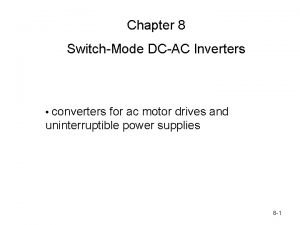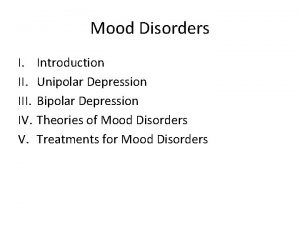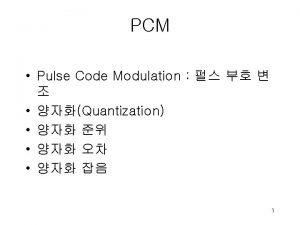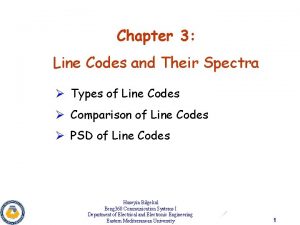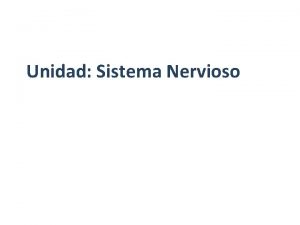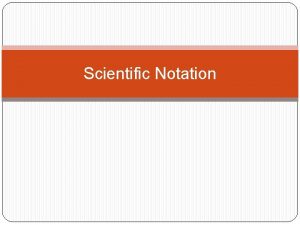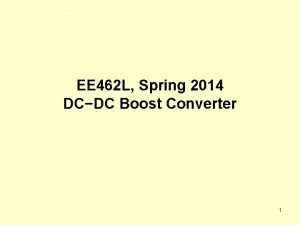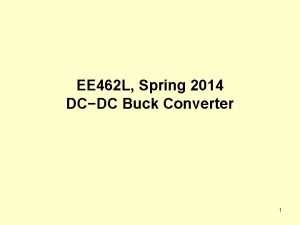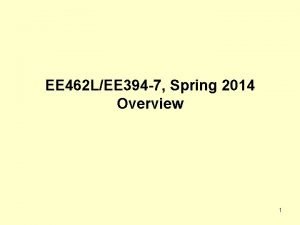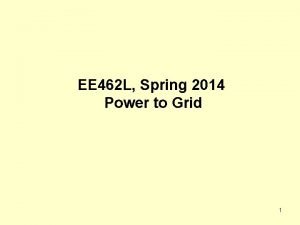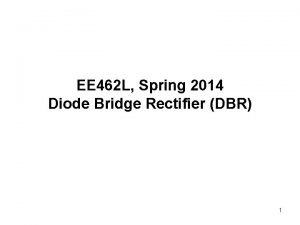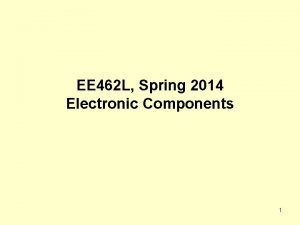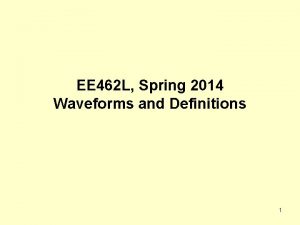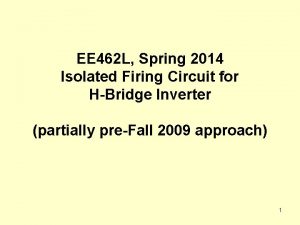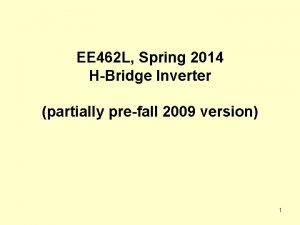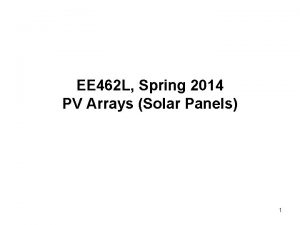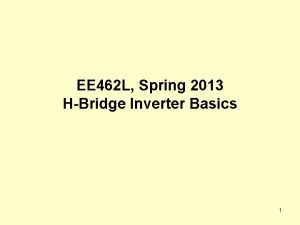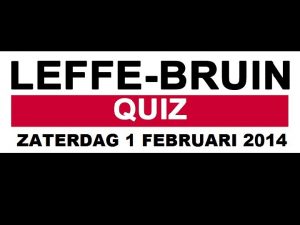EE 462 L Spring 2014 Implementation of Unipolar





















- Slides: 21

EE 462 L, Spring 2014 Implementation of Unipolar PWM Modulation for H-Bridge Inverter (pre-fall 2009 - but discrete components provide a better sense of how this circuit operates) 1

H-Bridge Inverter Basics – Creating AC from DC Switching rules Either A+ or A– is closed, but never at the same time Either B+ or B– is closed, but never at the same time Vdc A+ Va B+ Load A– ! Vb B– Can use identical isolated firing signals for A+, A–, with inverting and noninverting drivers to turn on, turn off simultaneously Same idea for B+, B– The A+, A– firing signal is a scaled version of Va The B+, B– firing signal is a scaled version of Vb The difference in the two firing signals is a scaled version of Vab 2

! Implementation of Unipolar PWM Vcont is the input signal we want to amplify at the output of the inverter. Vcont is usually a sinewave, but it can also be a music signal. Vcont Vtri −Vcont The implementation rules are: Vcont > Vtri , close switch A+, open switch A– , so voltage Va = Vdc Vcont < Vtri , open switch A+, close switch A– , so voltage Va = 0 –Vcont > Vtri , close switch B+, open switch B– , so voltage Vb = Vdc –Vcont < Vtri , open switch B+, close switch B– , so voltage Vb = 0 Vtri is a triangle wave whose frequency is at least 30 times greater than Vcont. Ratio ma = peak of control signal divided by peak of triangle wave 3 Ratio mf = frequency of triangle wave divided by frequency of control signal

! Implementation of Unipolar PWM Modulation for H-Bridge Inverter Vload Progressively wider pulses at the center Progressively (peak of narrower pulses sinusoid) at the edges Vdc Unipolar Pulse-Width Modulation (PWM) −Vdc 4

The four firing circuits do not have the same ground reference. Thus, the firing circuits require isolation. ! Vdc (source of power delivered to load) A+ Local ground reference for A+ firing circuit S S S Load A– Local ground reference for A− firing circuit B+ Local ground reference for B+ firing circuit B– S Local ground reference for B− firing circuit 5

6

This year’s circuit 7

Output of the Comparator Chip Comparator Gives V(A+, A–) wrt. Common (0 V) V(A+, A–) +12 V from DC-DC chip 1. 5 kΩ +12 V 1. 5 kΩ – 12 V 270 kΩ Vtri 8 1 Comp 5 1 kΩ Vcont 4 Vcont < Vtri Since the comparator compares signals that can be either positive or negative, the comparator must be powered by ±V supply Use V(A+, A–) wrt. – 12 V 270 kΩ –Vcont > Vtri +24 V Vcont > Vtri – 12 V from DC-DC chip 0 V Common (0 V) from DC-DC chip Vcont < Vtri 8

Comparator Gives V(B+, B–) wrt. Common (0 V) Output of the Comparator Chip V(B+, B–) +12 V from DC-DC chip –Vcont > Vtri +12 V 1. 5 kΩ – 12 V 1. 5 kΩ 270 kΩ Vtri 8 1 Comp 5 1 kΩ Vcont 4 Since the comparator compares signals that can be either positive or negative, the comparator must be powered by ±V supply Use V(B+, B–) wrt. – 12 V 270 kΩ –Vcont – Vcont < Vtri – 12 V from DC-DC chip Common (0 V) from DC-DC chip – Vcont > Vtri +24 V 0 V – Vcont < Vtri 9

This year’s circuit 10

11

12

13

14

+4 V 0 V − 4 V 15

+24 V 0 V 16

+24 V 0 V 17

+24 V 0 V − 24 V 18

+24 V 0 V − 24 V Flat toping indicates the onset of overmodulation +24 V 0 V − 24 V 19

Approaching a square wave +24 V 0 V − 24 V 20

21
 Hisd spring break 2014
Hisd spring break 2014 Dcac converters
Dcac converters Unipolar disorder
Unipolar disorder Unipolar neuron
Unipolar neuron Unipolar
Unipolar Unipolar neurons are found in
Unipolar neurons are found in Types of line code
Types of line code Barrera hematoencefalica
Barrera hematoencefalica Unipolar neurons are found in
Unipolar neurons are found in Unipolar neuron
Unipolar neuron Hebbian learning rule
Hebbian learning rule Unipolar
Unipolar Yxlon xray
Yxlon xray Ndice
Ndice Unipolar continuous activation function
Unipolar continuous activation function Four seasons korean movie
Four seasons korean movie Fall months
Fall months 462 na in scientific notation
462 na in scientific notation Ie 462
Ie 462 Heer geef vrede
Heer geef vrede Ie 462
Ie 462 Ie 462
Ie 462

